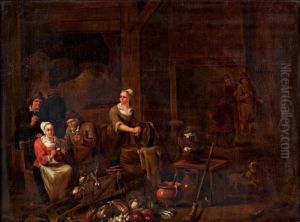Jan Baptist Nollekens Paintings
Jan Baptist Nollekens was a Flemish sculptor born in Antwerp in 1702. Although often confused with his more famous son, Joseph Nollekens, a British sculptor of the neoclassical era, Jan Baptist established his own artistic reputation during the Baroque period. His work was primarily influenced by the dramatic and ornamental styles that characterized the Baroque movement in Flemish art.
After receiving his initial artistic training, Jan Baptist Nollekens likely continued to refine his skills under the tutelage of prominent artists of the time. However, specific details about his apprenticeship or his masters are not well-documented. Nollekens worked in various materials, including wood, stone, and marble, and he was known for his religious sculptures and decorative works that adorned churches and other public buildings.
During his career, Nollekens produced a number of significant works that contributed to his reputation. He created altarpieces, religious statues, and other ecclesiastical objects that were celebrated for their expressive style and technical skill. His sculptures often featured intricate details and a dynamic sense of movement, which were hallmarks of the Baroque aesthetic.
Jan Baptist Nollekens' career was relatively short-lived as he died in 1748. Despite his early death, his legacy lived on through his son, Joseph Nollekens, who became one of the most prominent sculptors in Britain during the late 18th and early 19th centuries. Jan Baptist's influence on his son's work can be seen in the younger Nollekens' early sculptures, which exhibit a strong sense of form and decoration that harkens back to his father's Baroque sensibilities.









